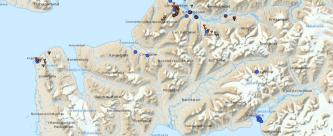“There will be more rockslides. In the video, we can see, among other, ice wedges thawing and underground channels flushing water into the permafrost. There is no doubt that climate change is undermining the stability of the mountains", says researcher Reginald Hermanns at the Geological Survey of Norway (NGU).
Increasing Warming
Together with the Federal Institute for Geosciences and Natural Resources (BGR), has NGU conducted field-basedresearch on deformed rock slopes in Isfjordenover the past few years.
Forkastningsfjellet was affected by a giant rockslide of more than 200 million cubic meters more than 4,000 years ago, leaving behind a highly varied topography with steep slopes, plateaus, and fault blocks. At the same time, aerial photographs dating back to the 1930s indicate that the mountain has been stable throughout the last century.
“The 2016 rockslide marked a change of state of the slope from dormant to active. Over the past seven years, we have observed rapid surface changes, which are related to increasing effects of global warming that includes the increased runoff of surface water from permafrost slopes. In November 2022, there was a landslide of approximately 500,000 cubic meters", explains Hermanns.
Melting of Ice Wedges
Using various methods, researchers have measured both movements and temperatures on that mountain. Before the 2022 landslide, deep, open cracks were recorded, which in the first years after 2017 expanded by 10 centimeters and in 2021/2022 by 16 centimeters per year.
“There is no doubt that the permafrost is degrading in this coastal area. This is shown, among other, by the formation of new underground water channels and the melting of ice wedges, which originally stabilize the rock slope. The binding effect in the slopes becomes less as the ice wedges warm and thaw. At the same time, the increasing pressure from melting water leads to the expansion of crack zones in the unstable mountain areas, thereby causing the mountain slopes to collapse", explains Reginald Hermanns.
Changes are happening fast
The drone video provides a unique insight into the geological structures of the mountain area, and the scientists point out that these drastic changes are occurring rapidly.
“There will be more changes here. We have also tried to model any possible displacement waves for the landslides that occurred in 2016 and 2022, but the fjord here is so shallow that it reduces the risk of creating displacement waves. No displacement waves were observed in connection with the landslides in 2016 and 2022," emphasizes Reginald Hermanns.

